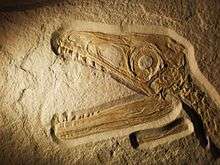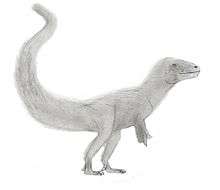Sciurumimus
| Sciurumimus Temporal range: Late Jurassic, 150 Ma | |
|---|---|
 | |
| The juvenile type specimen | |
| Scientific classification | |
| Kingdom: | Animalia |
| Phylum: | Chordata |
| Class: | Reptilia |
| Clade: | Dinosauria |
| Order: | Saurischia |
| Suborder: | Theropoda |
| Clade: | Coelurosauria |
| Genus: | †Sciurumimus Rauhut et al., 2012 |
| Species: | †S. albersdoerferi |
| Binomial name | |
| Sciurumimus albersdoerferi Rauhut et al., 2012 | |
Sciurumimus ("Squirrel-mimic," named for the tail feathers growing in a manner reminiscent of the fur on a squirrel's tail) is an extinct genus of coelurosaurian theropods from the Late Jurassic of Germany. It is known from a single juvenile specimen representing the type species, Sciurumimus albersdoerferi, which was found in a limestone quarry close to Painten in Lower Bavaria.[1] The specimen was preserved with traces of feather-like filaments.[2]
The Sciurumimus specimen was first announced in 2011 in an informal presentation,[3] but not formally described and named until the following year.[1]
Classification


When first discovered, a phylogenetic analysis suggested that Sciurumimus may have been a primitive member of the Megalosauroidea, a clade of large carnivorous dinosaurs more primitive than many other well-known theropods like the tyrannosauroids and carnosaurs, making it the most basal known feathered theropod.[1] This classification was supported by one of three initial analyses conducted by the scientists who described it. The other two analysis, which the authors regarded as less well supported, found it as more closely related to Monolophosaurus and Avetheropoda, and in an unresolved position among avetheropods and megalosauroids, respectively. The exact position in the various analyses was difficult to determine due to the fact that the only known specimen is a very young juvenile.[1]
This initial study was criticized by several researchers, who noted that some of the old analysis the scientists used to plug in data from the new fossil were incomplete and missing relevant data on various species.[4][5] The relationships of Sciurumimus were tested in 2013, when an analysis containing all of the original data, plus additional data and corrections, was published in the journal Nature. This revised analysis found Sciurumimus to be one of the most primitive members of the Coelurosauria, more derived than the megalosauroids.[6]
References
- 1 2 3 4 Rauhut, O. W. M.; Foth, C.; Tischlinger, H.; Norell, M. A. (2012). "Exceptionally preserved juvenile megalosauroid theropod dinosaur with filamentous integument from the Late Jurassic of Germany". Proceedings of the National Academy of Sciences. 109 (29): 11746–11751. doi:10.1073/pnas.1203238109. PMC 3406838
 . PMID 22753486.
. PMID 22753486. - ↑ Switek, B. (2012). "Rise of the fuzzy dinosaurs". Nature. doi:10.1038/nature.2012.10933.
- ↑ Rauhut and Foth, 2011. New information on Late Jurassic theropod dinosaurs from Southern Germany. IV Congresso Latinoamericano Paleontologia de Vertebrados.
- ↑ Mortimer, M. 2013. "Coelurosauria", The Theropod Database. Accessed online 09-AUG-2013.http://archosaur.us/theropoddatabase/Coelurosauria.htm#Sciurumimusalbersdoerferi
- ↑ Mortimer, M. and Marjanovic, D. (in prep.) http://archosaur.us/theropoddatabase/Coelurosauria.htm#Sciurumimusalbersdoerferi
- ↑ Godefroit, Pascal; Cau, Andrea; Hu, Dong-Yu; Escuillié, François; Wu, Wenhao; Dyke, Gareth (2013). "A Jurassic avialan dinosaur from China resolves the early phylogenetic history of birds". Nature. 498 (7454): 359–362. Bibcode:2013Natur.498..359G. doi:10.1038/nature12168. PMID 23719374.